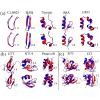当前位置:
X-MOL 学术
›
Phys. Rev. E
›
论文详情
Our official English website, www.x-mol.net, welcomes your feedback! (Note: you will need to create a separate account there.)
Using the generalized Born surface area model to fold proteins yields more effective sampling while qualitatively preserving the folding landscape.
Physical Review E ( IF 2.4 ) Pub Date : 2020-06-22 , DOI: 10.1103/physreve.101.062417 Peng Tao 1 , Yi Xiao 1
Physical Review E ( IF 2.4 ) Pub Date : 2020-06-22 , DOI: 10.1103/physreve.101.062417 Peng Tao 1 , Yi Xiao 1
Affiliation

|
Protein folding is a long-standing problem and has been widely investigated using molecular dynamics simulations with both explicit and implicit solvents. However, to what extent the folding mechanisms observed in two water models agree remains an open question. In this study, ab initio folding simulations of ten proteins with different topologies are performed in two combinations of force fields and water models (ff14SB+TIP3P and ff14SBonlysc+GB-Neck2). Interestingly, the latter combination not only folds more proteins but also provides a better balance of different secondary structures than the former in the same number of integration time steps. More importantly, the folding pathways found in the two types of simulations are conserved and they may only differ in their weights. Our results suggest that simulations with an implicit solvent may also be suitable for the investigation of the mechanism of protein folding.
中文翻译:

使用广义的Born表面积模型折叠蛋白质可以更有效地采样,同时可以定性地保留折叠景观。
蛋白质折叠是一个长期存在的问题,已经使用显式和隐式溶剂的分子动力学模拟进行了广泛研究。但是,在两个水模型中观察到的折叠机制在多大程度上一致仍然是一个悬而未决的问题。在这项研究中,从头开始在力场和水模型的两个组合(ff14SB + TIP3P和ff14SBonlysc + GB-Neck2)中对十个具有不同拓扑结构的蛋白质进行了折叠模拟。有趣的是,在相同的整合时间步骤中,后一种组合不仅可以折叠更多的蛋白质,而且在不同二级结构上的平衡更好。更重要的是,在两种类型的模拟中找到的折叠路径均得以保留,并且它们的权重可能不同。我们的结果表明,使用隐式溶剂进行的模拟也可能适用于蛋白质折叠机制的研究。
更新日期:2020-06-22
中文翻译:

使用广义的Born表面积模型折叠蛋白质可以更有效地采样,同时可以定性地保留折叠景观。
蛋白质折叠是一个长期存在的问题,已经使用显式和隐式溶剂的分子动力学模拟进行了广泛研究。但是,在两个水模型中观察到的折叠机制在多大程度上一致仍然是一个悬而未决的问题。在这项研究中,从头开始在力场和水模型的两个组合(ff14SB + TIP3P和ff14SBonlysc + GB-Neck2)中对十个具有不同拓扑结构的蛋白质进行了折叠模拟。有趣的是,在相同的整合时间步骤中,后一种组合不仅可以折叠更多的蛋白质,而且在不同二级结构上的平衡更好。更重要的是,在两种类型的模拟中找到的折叠路径均得以保留,并且它们的权重可能不同。我们的结果表明,使用隐式溶剂进行的模拟也可能适用于蛋白质折叠机制的研究。


























 京公网安备 11010802027423号
京公网安备 11010802027423号